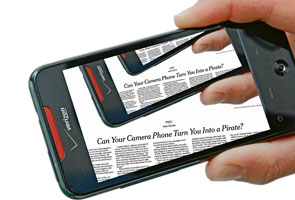- Home
- Others
- Others News
- Can your camera phone turn you into a pirate?
Can your camera phone turn you into a pirate?
By Nick Bilton, New York Times | Updated: 5 June 2012 02:20 IST

Click Here to Add Gadgets360 As A Trusted Source

Advertisement
My wife and I sat cross-legged on the floor of a local Barnes & Noble store recently, surrounded by several large piles of books. We were searching for interior design ideas for a new home that we are planning to buy.
As we lobbed the books back and forth, sharing kitchen layouts and hardwood floor textures, we snapped a dozen pictures of book pages with our iPhones. We wanted to share them later with our contractor.
After a couple of hours of this, we placed the books back on the shelf and went home, without buying a thing. But the digital images came home with us in our smartphones.
Later that evening, I felt a few pangs of guilt. I asked my wife: Did we do anything wrong? And, I wondered, had we broken any laws by photographing those pages?
It's not as if we had destroyed anything: We didn't rip out any pages. But if we had wheeled a copier machine into the store, you can be sure the management would have soon wheeled us and the machine out of there.
But our smartphones really functioned as hand-held copiers. Did we indeed go too far?
I asked Julie A. Ahrens, associate director of the Fair Use Project at the Stanford Law School. "The core issue here is that you are creating a copy of something rather than buying it," she said. "Is it morally incorrect? Maybe. But it entirely depends how much of the book you copy, and what you do with that copy, that would determine if it was illegal."
These kinds of questions aren't entirely new, of course. Consider the heyday of the photocopier, in the 1960s and early '70s. After the Xerox copying machine was introduced into offices in 1959, it quickly found its way into libraries. The price of copies dropped, and people began to photocopy books and journals in large numbers. Many students discovered that it was cheaper to photocopy a friend's textbook -- or a copy of his copy -- than to buy the book.
By the 1970s, the publishing industry saw the copier as the enemy, and publishers began to file lawsuits -- prefiguring, by several decades, the music industry's suits against those who would download free music over the Internet.
Time magazine covered this earlier era of copyright confusion. The photocopier's opponents said the technology enabled theft and "stifled creativity and punched holes in the copyright laws," according to one article.
After endless legal battles, the publishing industry succeeded in persuading Congress to pass the Copyright Act of 1976, which defined "fair use" of copyrighted material and sought to establish a set of rules for ownership of content. It allowed limited replication of snippets of music, video and text, and it gave teachers the right to photocopy certain materials without having to pay hefty fees to publishers.
That worked well enough -- for a while. But it didn't take long before new technologies came along. The Internet and other digital tools like file sharing enabled new forms of duplication and set off new copyright disputes.
Stan Liebowitz, a professor of economics at the University of Texas at Dallas and the director of its Center for the Analysis of Property Rights and Innovation, spent years investigating the economic impact of the Xerox machine on the publishing industry.
He said my cellphone copying bore some resemblance to that earlier behavior, but because it depended on the portability and ubiquity of the phone's camera, he said it was closer to music piracy. "When you're talking about people making copies of things with their cellphones, it's much closer to people making MP3s than people using Xerox copies of books," Mr. Liebowitz said. "In the 1970s, everyone didn't have a photocopier sitting in their home. Now everyone has a cellphone in their pocket that can easily copy anything."
Music file sharing didn't become a mass activity until a simple digital compression technology, MP3, was invented. That made it simple to copy (in the industry's view, steal) the music.
As the technology in cellphones advances, higher-resolution cameras, image-enhancing software and high-clarity screens make it delightfully easy to capture a photograph and view it later. There may not be Web sites devoted to purloined pictures -- there are such sites for music or videos -- but many people have a cavalier attitude toward using cameras to obtain copyrighted material.
Charles Nesson, the Weld professor of law at Harvard Law School and founder of the Berkman Center for Internet and Society there, also said that the act of "documenting" a book, as he called it, bears many similarities to pirating music. It could lead to a new wave of legal cases brought by bookstores or publishers, he said, much like the litigation brought by music companies against sites like Napster and LimeWire and their users.
"If people are taking a picture of a picture to take with them, then is it is exactly like the MP3 issue," Mr. Nesson said.
Need I worry yet that a phalanx of lawyers will soon grab me between the Home Décor and New Age aisles at Barnes & Noble?
Mr. Nesson says the question is unanswerable for now. The music industry, he says, has a strategy of going after individuals while not addressing changing technologies as they apply to copyright law. The publishing industry could well do the same, he adds. "I think the law and the draconian action of copyright holders will stay the way it is for a long time," said Mr. Nesson "There's change in the air, but it's not a change that's going to come very quickly."
Indeed, it could be years before the publishing industry feels real economic pressure caused by people who take pictures of books or magazines with their mobile phones. In fact, it's quite possible that digital technology will make this particular problem moot.
As Ms. Ahrens says, "By the time this becomes an issue, we might not even have bookstores anymore."
As we lobbed the books back and forth, sharing kitchen layouts and hardwood floor textures, we snapped a dozen pictures of book pages with our iPhones. We wanted to share them later with our contractor.
After a couple of hours of this, we placed the books back on the shelf and went home, without buying a thing. But the digital images came home with us in our smartphones.
Later that evening, I felt a few pangs of guilt. I asked my wife: Did we do anything wrong? And, I wondered, had we broken any laws by photographing those pages?
It's not as if we had destroyed anything: We didn't rip out any pages. But if we had wheeled a copier machine into the store, you can be sure the management would have soon wheeled us and the machine out of there.
But our smartphones really functioned as hand-held copiers. Did we indeed go too far?
I asked Julie A. Ahrens, associate director of the Fair Use Project at the Stanford Law School. "The core issue here is that you are creating a copy of something rather than buying it," she said. "Is it morally incorrect? Maybe. But it entirely depends how much of the book you copy, and what you do with that copy, that would determine if it was illegal."
These kinds of questions aren't entirely new, of course. Consider the heyday of the photocopier, in the 1960s and early '70s. After the Xerox copying machine was introduced into offices in 1959, it quickly found its way into libraries. The price of copies dropped, and people began to photocopy books and journals in large numbers. Many students discovered that it was cheaper to photocopy a friend's textbook -- or a copy of his copy -- than to buy the book.
By the 1970s, the publishing industry saw the copier as the enemy, and publishers began to file lawsuits -- prefiguring, by several decades, the music industry's suits against those who would download free music over the Internet.
Time magazine covered this earlier era of copyright confusion. The photocopier's opponents said the technology enabled theft and "stifled creativity and punched holes in the copyright laws," according to one article.
After endless legal battles, the publishing industry succeeded in persuading Congress to pass the Copyright Act of 1976, which defined "fair use" of copyrighted material and sought to establish a set of rules for ownership of content. It allowed limited replication of snippets of music, video and text, and it gave teachers the right to photocopy certain materials without having to pay hefty fees to publishers.
That worked well enough -- for a while. But it didn't take long before new technologies came along. The Internet and other digital tools like file sharing enabled new forms of duplication and set off new copyright disputes.
Stan Liebowitz, a professor of economics at the University of Texas at Dallas and the director of its Center for the Analysis of Property Rights and Innovation, spent years investigating the economic impact of the Xerox machine on the publishing industry.
He said my cellphone copying bore some resemblance to that earlier behavior, but because it depended on the portability and ubiquity of the phone's camera, he said it was closer to music piracy. "When you're talking about people making copies of things with their cellphones, it's much closer to people making MP3s than people using Xerox copies of books," Mr. Liebowitz said. "In the 1970s, everyone didn't have a photocopier sitting in their home. Now everyone has a cellphone in their pocket that can easily copy anything."
Music file sharing didn't become a mass activity until a simple digital compression technology, MP3, was invented. That made it simple to copy (in the industry's view, steal) the music.
As the technology in cellphones advances, higher-resolution cameras, image-enhancing software and high-clarity screens make it delightfully easy to capture a photograph and view it later. There may not be Web sites devoted to purloined pictures -- there are such sites for music or videos -- but many people have a cavalier attitude toward using cameras to obtain copyrighted material.
Charles Nesson, the Weld professor of law at Harvard Law School and founder of the Berkman Center for Internet and Society there, also said that the act of "documenting" a book, as he called it, bears many similarities to pirating music. It could lead to a new wave of legal cases brought by bookstores or publishers, he said, much like the litigation brought by music companies against sites like Napster and LimeWire and their users.
"If people are taking a picture of a picture to take with them, then is it is exactly like the MP3 issue," Mr. Nesson said.
Need I worry yet that a phalanx of lawyers will soon grab me between the Home Décor and New Age aisles at Barnes & Noble?
Mr. Nesson says the question is unanswerable for now. The music industry, he says, has a strategy of going after individuals while not addressing changing technologies as they apply to copyright law. The publishing industry could well do the same, he adds. "I think the law and the draconian action of copyright holders will stay the way it is for a long time," said Mr. Nesson "There's change in the air, but it's not a change that's going to come very quickly."
Indeed, it could be years before the publishing industry feels real economic pressure caused by people who take pictures of books or magazines with their mobile phones. In fact, it's quite possible that digital technology will make this particular problem moot.
As Ms. Ahrens says, "By the time this becomes an issue, we might not even have bookstores anymore."
Comments
Get your daily dose of tech news, reviews, and insights, in under 80 characters on Gadgets 360 Turbo. Connect with fellow tech lovers on our Forum. Follow us on X, Facebook, WhatsApp, Threads and Google News for instant updates. Catch all the action on our YouTube channel.
Related Stories
Popular on Gadgets
- Samsung Galaxy Unpacked 2025
- ChatGPT
- Redmi Note 14 Pro+
- iPhone 16
- Apple Vision Pro
- Oneplus 12
- OnePlus Nord CE 3 Lite 5G
- iPhone 13
- Xiaomi 14 Pro
- Oppo Find N3
- Tecno Spark Go (2023)
- Realme V30
- Best Phones Under 25000
- Samsung Galaxy S24 Series
- Cryptocurrency
- iQoo 12
- Samsung Galaxy S24 Ultra
- Giottus
- Samsung Galaxy Z Flip 5
- Apple 'Scary Fast'
- Housefull 5
- GoPro Hero 12 Black Review
- Invincible Season 2
- JioGlass
- HD Ready TV
- Laptop Under 50000
- Smartwatch Under 10000
- Latest Mobile Phones
- Compare Phones
Latest Gadgets
- OnePlus 15R
- Realme Narzo 90x 5G
- Realme Narzo 90 5G
- Vivo S50 Pro Mini
- Vivo S50
- OPPO Reno 15c
- Redmi Note 15 5G
- Redmi Note 15 Pro 5G
- Asus ProArt P16
- MacBook Pro 14-inch (M5, 2025)
- Infinix Xpad Edge
- OnePlus Pad Go 2
- OnePlus Watch Lite
- Just Corseca Skywatch Pro
- Acerpure Nitro Z Series 100-inch QLED TV
- Samsung 43 Inch LED Ultra HD (4K) Smart TV (UA43UE81AFULXL)
- Asus ROG Ally
- Nintendo Switch Lite
- Haier 1.6 Ton 5 Star Inverter Split AC (HSU19G-MZAID5BN-INV)
- Haier 1.6 Ton 5 Star Inverter Split AC (HSU19G-MZAIM5BN-INV)
© Copyright Red Pixels Ventures Limited 2025. All rights reserved.

















